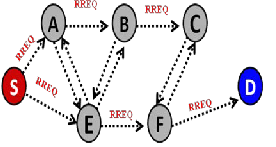AODV Simulation code in NS2
How to simulate AODV Protocol using NS2 codeWhat is AODV Protocol?TCL Script for AODV simulation in ns2.
AODV refers to An on-demand routing protocol for wireless a network that uses traditional routing tables to store routing information.AODV protocol uses timers at each node and expires the routing table entry after the route is not used for a certain period of time.We have successfully delivered more than 50+ AODV Protocol Simulation in ns2 Project to B.E/B.Tech/M.E/M.Tech and PhD Scholars.Get in touch with us for customized AODV Protocol Projects.

Download Sample source code for AODV Protocol simulation using Ns2.For customized AODV Simulation code in Ns2,Contact us for more detail information.
Characteristics of AODV Protocol:
- Multihop.
- Low power
- Auto configured.
- Dynamic
- Autonomous.
- Peer-to-peer.
- Zero-administration.
Benefits of AODV Simulation using Ns2 :
- Wireless data rates.
- Additional security exposure.
- Scalability.
- Non-ubiquitous coverage.
- Power budget vs latency.
NS2 Projects Video Output
See our Latest Video Output of Ns2 Projects on Various Domain.
Ns2 Projects
Customized NS2 Projects for B.E/B.Tech/M.E/M.Tech/Ms/PhD Scholars.
Ns2 Projects Screen Shots
Ns2 Projects Screen Shots.Regular Update of NS2 Projects Screenshots here!
AODV Simulation Code In NS2
aodvHelloTimer::handle(Event*) {
if (agent->rtable.rt_has_active_route())
agent->sendHello();
double interval = MinHelloInterval + ((MaxHelloInterval - MinHelloInterval) * Random::uniform());
assert(interval >= 0);
Scheduler::instance().schedule(this, &intr, interval);
}
void
aodvNeighborTimer::handle(Event*) {
agent->nb_purge();
Scheduler::instance().schedule(this, &intr, HELLO_INTERVAL);
}
void
aodvRouteCacheTimer::handle(Event*) {
agent->rt_purge();
#define FREQUENCY 0.5
Scheduler::instance().schedule(this, &intr, FREQUENCY);
}
void
aodvLocalRepairTimer::handle(Event* p) {
aodv_rt_entry *rt;
struct hdr_ip *ih = HDR_IP( (Packet *)p);
rt = agent->rtable.rt_lookup(ih->daddr());
if (rt && rt->rt_flags != RTF_UP) {
agent->rt_down(rt);
#ifdef DEBUG
fprintf(stderr,"Node %d: Dst - %d, failed local repair\n",index, rt->rt_dst);
#endif
}
Packet::free((Packet *)p);
}
Journal Support for Research Scholars

Ns2 Projects Work Progress
- MANET – Mobile Ad Hoc Network 95%
- VANET – Vechicle Ad Hoc Netwok 97%
- LTE – Long Term Evolution 78%
- IoT – Internet of Things 90%
- Wireless Sensor Network 89%
- Network Security 89%
- Ns2 Attacks 96%
- Cognitive Radio Network 85%
- Parallel and Distributed Computing 73%
- SDN – Software Defined Networking 95%
- P2P , Video Streaming , Peersim 96%
- IPV4 , IPV6 88%
- 4G Network , 5G Network 80%
- Visual , Underwater Sensor Network 79%
- Multicasting Communication 84%
- Wimax, WiFi 90%
- OFDMA 94%
Our Achievements – Ns2 Projects

